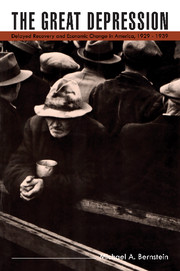Book contents
- Frontmatter
- Contents
- List of tables
- List of figures
- Editors' preface
- Preface
- Introduction: The puzzle of the 1930s
- 1 Long-term economic growth and the problem of recovery in the United States, 1929–39
- 2 The transformation of American industry in the interwar period
- 3 A reassessment of investment failure in the interwar economy
- 4 Technical change during the interwar years
- 5 The effective demand problem of the interwar period. I: Cyclical and structural unemployment
- 6 The effective demand problem of the interwar period. II: Cyclical and secular changes in final demand
- 7 New Deal economic policy and the problem of recovery
- 8 Contemporary economic problems in historical perspective
- Bibliography
- Index
1 - Long-term economic growth and the problem of recovery in the United States, 1929–39
Published online by Cambridge University Press: 06 July 2010
- Frontmatter
- Contents
- List of tables
- List of figures
- Editors' preface
- Preface
- Introduction: The puzzle of the 1930s
- 1 Long-term economic growth and the problem of recovery in the United States, 1929–39
- 2 The transformation of American industry in the interwar period
- 3 A reassessment of investment failure in the interwar economy
- 4 Technical change during the interwar years
- 5 The effective demand problem of the interwar period. I: Cyclical and structural unemployment
- 6 The effective demand problem of the interwar period. II: Cyclical and secular changes in final demand
- 7 New Deal economic policy and the problem of recovery
- 8 Contemporary economic problems in historical perspective
- Bibliography
- Index
Summary
It has generally been the fate of economic theory to run a losing race against the course of history, and never to have completed the analysis of one phase of economic development before another takes its place.
– Joan RobinsonAlthough the American economy has suffered several financial panics in its history, none had the legacy of the panic of 1929. My concern is to examine the economy's failure to recover in the thirties – a failure epitomized by the fact that it was not until the outbreak of war in Europe that industrial production reached its pre-crash levels and the unemployment rate fell below a decennial average of 18 percent.
A theory of long-term growth
Secular economic growth is not well understood. Most analytical traditions view the trend in strictly quantitative terms, by means of the concept of the “natural rate of growth,” with qualitative change most often relegated to the status of an exogenous factor. In the one major analytical tradition that seeks to integrate the secular development of an economy with its short-run behavior, namely the Marxian, the theory of long-term growth is subsumed within a theory of the firm that focuses on the concentration of capital into larger enterprises and a decline in the number of independent firms.
- Type
- Chapter
- Information
- The Great DepressionDelayed Recovery and Economic Change in America, 1929–1939, pp. 21 - 47Publisher: Cambridge University PressPrint publication year: 1987

